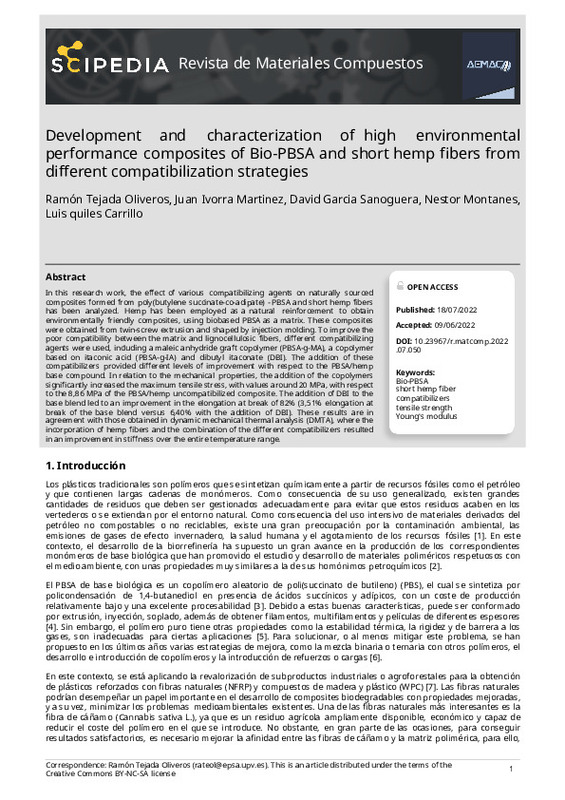Tejada-Oliveros, R.; Ivorra-Martínez, J.; Garcia-Sanoguera, D.; Montanes, N.; Quiles-Carrillo, L. (2022). Development and characterization of high environmental performance composites of Bio-PBSA and short hemp fibers from different compatibilization strategies. Materiales compuestos. 1(1):1-5. https://doi.org/10.23967/r.matcomp.2022.07.050
Por favor, use este identificador para citar o enlazar este ítem: http://hdl.handle.net/10251/192913
|
Título:
|
Development and characterization of high environmental performance composites of Bio-PBSA and short hemp fibers from different compatibilization strategies
|
|
Otro titulo:
|
Desarrollo y caracterización de compuestos de alto rendimiento medioambiental de Bio-PBSA y fibras cortas de cáñamo a partir de diferentes estrategias de compatibilización
|
|
Autor:
|
 Tejada-Oliveros, Ramón
Tejada-Oliveros, Ramón

 Ivorra-Martínez, Juan
Ivorra-Martínez, Juan

 Garcia-Sanoguera, David
Garcia-Sanoguera, David

 Montanes, Nestor
Montanes, Nestor

 Quiles-Carrillo, Luis
Quiles-Carrillo, Luis
|
|
Entidad UPV:
|
Universitat Politècnica de València. Escuela Politécnica Superior de Alcoy - Escola Politècnica Superior d'Alcoi
Universitat Politècnica de València. Instituto de Tecnología de Materiales - Institut de Tecnologia de Materials
|
|
Fecha difusión:
|
|
|
Resumen:
|
[EN] In this research work, the effect of various compatibilizing agents on naturally sourced composites formed from poly(butylene succinate-co-adipate) - PBSA and short hemp fibers has been analyzed. Hemp has been employed ...[+]
[EN] In this research work, the effect of various compatibilizing agents on naturally sourced composites formed from poly(butylene succinate-co-adipate) - PBSA and short hemp fibers has been analyzed. Hemp has been employed as a natural reinforcement to obtain environmentally friendly composites, using biobased PBSA as a matrix. These composites were obtained from twin-screw extrusion and shaped by injection molding. To improve the poor compatibility between the matrix and lignocellulosic fibers, different compatibilizing agents were used, including a maleic anhydride graft copolymer (PBSA-g-MA), a copolymer based on itaconic acid (PBSA-g-IA) and dibutyl itaconate (DBI). The addition of these compatibilizers provided different levels of improvement with respect to the PBSA/hemp base compound. In relation to the mechanical properties, the addition of the copolymers
significantly increased the maximum tensile stress, with values around 20 MPa, with respect to the 8,86 MPa of the PBSA/hemp uncompatibilized composite. The addition of DBI to the base blend led to an improvement in the elongation at break of 82% (3,51% elongation at break of the base blend versus 6,40% with the addition of DBI). These results are in agreement with those obtained in dynamic mechanical thermal analysis (DMTA), where the incorporation of hemp fibers and the combination of the different compatibilizers resulted in an improvement in stiffness over the entire temperature range.
[-]
|
|
Palabras clave:
|
Bio-PBSA
,
Short hemp fiber
,
Compatibilizers
,
Tensile strength
,
Young's modulus
|
|
Derechos de uso:
|
Reconocimiento - No comercial - Compartir igual (by-nc-sa)
|
|
Fuente:
|
Materiales compuestos. (eissn:
2531-0739
)
|
|
DOI:
|
10.23967/r.matcomp.2022.07.050
|
|
Editorial:
|
Asociación Española de Materiales Compuestos
|
|
Versión del editor:
|
https://doi.org/10.23967/r.matcomp.2022.07.050
|
|
Código del Proyecto:
|
info:eu-repo/grantAgreement/AEI/Plan Estatal de Investigación Científica y Técnica y de Innovación 2017-2020/PID2020-116496RB-C22/ES/OBTENCION DE NANOCOMPOSITES DE ORIGEN BIO A PARTIR DE RESIDUOS LIGNOCELULOSICOS PARA SU USO EN FILMS MULTICAPA/
info:eu-repo/grantAgreement/GENERALITAT VALENCIANA//AICO%2F2021%2F025//NUEVOS MATERIALES SOSTENIBLES DERIVADOS DE LA REVALORIZACIÓN DE RESIDUOS DE LA INDUSTRIA DE CÍTRICOS ¿ CitricNewLife/
info:eu-repo/grantAgreement/UPV//PAID-01-20/
info:eu-repo/grantAgreement/MCIU//FPU19%2F01759/
|
|
Agradecimientos:
|
Los autores agradecen la financiación otorgada gracias al proyecto con número de subvención PID2020-116496RB-C22
financiado por el Ministerio de Ciencia e Innovación MCIN/AEI/10.13039/501100011033 y número de subvención
...[+]
Los autores agradecen la financiación otorgada gracias al proyecto con número de subvención PID2020-116496RB-C22
financiado por el Ministerio de Ciencia e Innovación MCIN/AEI/10.13039/501100011033 y número de subvención
AICO/2021/025 financiado por la Generalitat Valenciana.
R. T.-O. quiere agradecer a la UPV la subvención recibida a través del programa PAID-01-20. J. I.-M. quiere agradecer la
beca FPU19/01759 financiada por MCIN/AEI/10.13039/501100011033 y por el FSE Invierte en tu futuro.
[-]
|
|
Tipo:
|
Artículo
|









